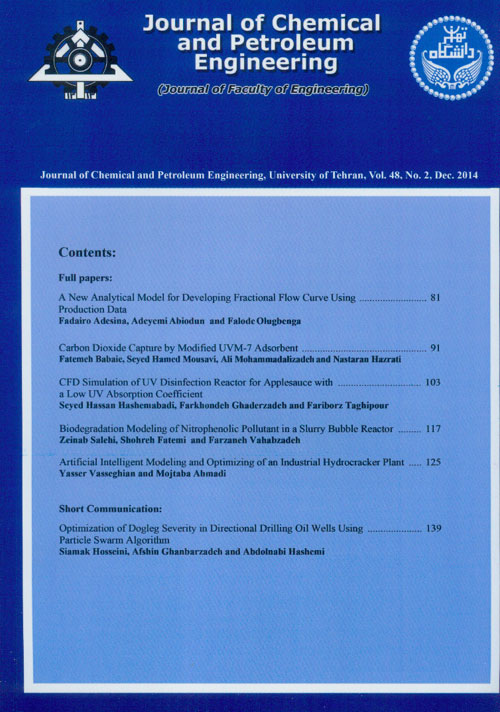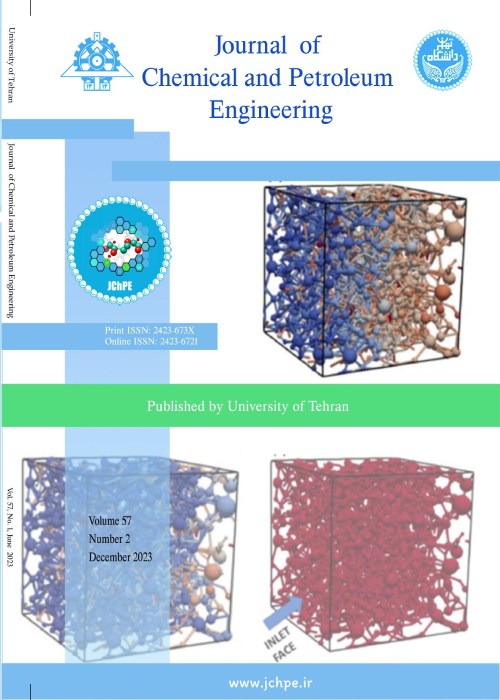فهرست مطالب

Journal of Chemical and Petroleum Engineering
Volume:48 Issue: 2, Dec 2014
- تاریخ انتشار: 1393/10/22
- تعداد عناوین: 6
-
-
Pages 81-90The immiscible displacement of oil by water through a porous and permeable reservoir rock can be described by the use of a fractional flow curves (fw versus Sw). Water flooding project parameters can be obtained from the fractional flow curve. However, developing a representative fractional flow curve for a specific reservoir can be quite challenging when fluid and special core analysis data is limited or compromised. Hence, a mathematical model for dependence of fw on Swis developed by solving material balance algorithm using production data. The results of the model were compared with forecasts from the conventional Bucklett Leverett fractional flow equation and Corey’s correlation and were found to be favorable with less time and effort.Keywords: Waterflooding, Fractional flow curve, Secondary recovery, buckley leverret
-
Pages 91-102In this study, bimodal meso-porous silica (UVM-7) synthesized and fabricated amino silane modified supports were characterized by powder X-ray diffraction (XRD), N2 adsorption/desorption, transmission electron microscope (TEM), elemental analysis and titration. Capacity of CO2 capture on modified bimodal pore structure silica at 70°C was calculated using breakthrough curves; and it was found that the modified UVM-7 captured more CO2 than unmodified UVM-7 and pore structure of UVM-7 make it suitable for loading large molecules such as tri-amino silanes. The adsorbents modified with tri-amino silane showed the largest capacity. Dynamic and kinetic of adsorption were investigated by mathematical models in order to prediction of adsorption behavior. Yoon Nelson model was successfully employed to describe the adsorption breakthrough curves of CO2 and Avrami model applied as a kinetic model and was in good agreement with experimental data in comparison with two other kinetic models including Lagergen’s pseudo-first and pseudo-second order models.Keywords: CO2, N2 Adsorption, Desorption Isotherm, Breakthrough, Carbon capture, Flue gas
-
Pages 103-116In this study, a Computational Fluid Dynamics (CFD) model was developed to evaluate ultraviolet disinfection applesauce reactor. To simulate UV reactors, three sets of equations, including hydrodynamics, radiation and species mass conservation were solved simultaneously. The Realizable k-e turbulence model and the discrete ordinate method were used to find the UV radiation profile through the reactor. Using the Chick-Watson kinetic model and the Eulerian framework, inactivation of applesauce microorganisms was simulated in the UV reactor. Simulation results for water disinfection in the UV reactor were evaluated by the reported experimental data. Simulation was extended for non-Newtonian fluid such as applesauce. Results show that the UV reactor is less effective in eliminating microorganisms from applesauce than from water because applesauce has a higher UV absorption rate. In order to achieve higher disinfection of the UV reactor for non-Newtonian fluids with high absorption, this study examined different parameters and makes suggestions for appropriate reactor design. Different designs for disinfection reactor were studied, due to higher UV absorption coefficient of applesauce, CFD simulations show that the inactivation of microorganisms in applesauce is less than water, consequently thin film or small radius reactors are appropriate design.Keywords: Computational fluid dynamics (CFD), Disinfection, Ultraviolet (UV) reactor, Non, Newtonian fluid, Reactor engineering
-
Pages 117-124Biodegradation kinetics of 4-nitrophenol (PNP) in aqueous solution by a gram negative soil bacterium, Ralstoniaeutropha was firstly studied in a small scale batch reactor. The degradation of PNP was evaluated at initial PNP concentrations ranging from 3 mg/L to 14 mg/L. The rate of PNP consumption by the bacterium culture was modeled using Monod and Contois kinetics in batch condition. PNP degradation by adapted R. eutropha was well fitted to the Monod equation for the pollutant with initial concentration of 3-8 mg/L, whereas for PNP with initial concentration of 14 mg/L the experimental data were better fitted to the Contois kinetic model. The process of degradation of PNP was scaled up in a slurry bubble reactor with 250 ml working volume in presence of 0.75 L/min air flow rate. The derived kinetic model was validated by comparison the outlet time dependent experimental data of PNP concentration with the model in the slurry bioreactor and the results showed good agreement between experiments and the model.Keywords: Biodegradation, p, Nitrophenol, Ralstoniaeutropha, Kinetic modeling, Slurry bubble reactor
-
Pages 125-137The main objective of this study is the modelling and optimization of an industrial Hydrocracker Unit (HU) by means of Adaptive Neuro Fuzzy Inference System (ANFIS) model. In this case, some data were collected from an industrial hydrocracker plant. Inputs of an ANFIS include flow rate of fresh feed and recycle hydrogen, temperature of reactors, mole percentage of H2 and H2S, feed flow rate and temperature of debutanizer, pressure of debutanizer receiver, top and bottom temperature and pressure of fractionator column. The network was employed to calculate the flow rate of gas oil, kerosene, Light Naphtha (LN), and Heavy Naphtha (HN).Unseen data points were used to check generalization capability of the best network. There were good adjustment between network estimations and unseen data. Finally optimization was performed to maximize the production volume percent of gas oil, kerosene, HN and LN and to identify the sets of optimum operating parameters in order to maximize yields of mentioned product. Optimum conditions were found as feed flow rate of 90.9 m3/h, reactor temperature of 378.4 °C, hydrogen flow rate of 54.31 MSCM/h and LN (feed vol.%) of 9.34.Keywords: Adaptive neuro fuzzy inference system, Modelling, Hydrocracker unit
-
Pages 139-151The dogleg severity is one of the most important parameters in directional drilling. Improvement of these indicators actually means choosing the best conditions for the directional drilling in order to reach the target point. Selection of high levels of the dogleg severity actually means minimizing well trajectory, but on the other hand, increases fatigue in drill string, increases torque and drag, particularly in the rotation mode. Therefore the aim is to define the index in an optimal range which meets both requirements. Particle swarm algorithm was used for optimization the dogleg severity. The final measured depth and directional well pattern were considered as an objective function and Build & Hold, respectively. Then the fatigue caused by the stresses exerted on the drill string, evaluated by modified Goodman equation simultaneously. The relationship between path parameters and the obligation to reach a target point in directional wells, converts the problem into a constrained optimization problem. Comparing the proposed directional drilling path in a drilled well in the Ahwaz oilfield with the responses obtained from the particle swarm algorithm indicated that the particle swarm algorithm is converged in finding the shortest path, and on the other hand, it decreases the time of using directional drilling equipment due to the selection of the proper dogleg severity. Note that it is likely to add other constraints to the optimization process which indicates the particle swarm algorithm efficiency in solving these problems.Keywords: Dogleg severity, Optimization, Particle swarm algorithms, Fatigue


